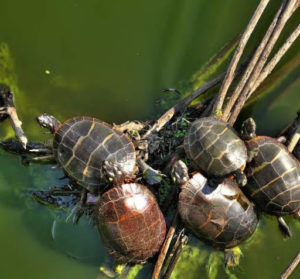-Written by Julia Adams, summer intern for Woodland Dunes Nature Center

It is always fascinating to learn about how other animals reproduce and raise their young. Recently while on vacation in Mexico, I observed sea turtles nesting on the beach. The process seemed to be long and tedious. Although there are no sea turtles, there are eleven different species of turtles that live in Wisconsin.
Painted Turtles are common turtles at the Woodland Dunes Nature Preserve. Female Painted Turtles nest between late May and mid-July. Similar to sea turtles, they lay their eggs in the sand in fairly close proximity to the water. When the female comes out of the water and finds a location that she feels may be a fit place for her nest, she presses her throat on the ground. This unusual behavior does not have a known purpose, however, she most likely does this to sense moisture, warmth, texture, or smell. Once she has picked her ideal location, she uses her back legs to dig her nest. She may build up mud and sand on her legs limiting her mobility and making her vulnerable to predators. To minimize this, she releases bladder water to lubricate the area. After the nest has been dug the female lays her eggs which appear white, elliptical, porous, and flexible. This entire process can take up to four hours to complete.
Each batch of eggs that the turtle lays is called a clutch. Painted turtles can lay up to five clutches per year, but the average is two. To protect their nest, painted turtles will sometimes dig false nests as diversions for predators. The eggs incubate for 72-80 days in the wild. During this time, the mother turtle goes back to the water. When it is time for the baby turtles to hatch, they use their front “egg tooth” to break the shell so they can emerge. Although they may hatch, not all baby turtles leave the nest immediately after they hatch. Hatchlings in the northern part of the US, including Wisconsin, hatch in the fall and arrange themselves in a symmetrical formation for the winter to emerge in the spring. At first hatchlings grow at a rapid rate and can even double their size in their first year. The females always grow larger than the males and in order to reach sexual maturity, they must be larger than the males. In Wisconsin and other northern regions males reach sexual maturity between the ages of seven and nine years while females are between eleven and sixteen years. Once this has happened, the turtles are ready to mate and lay more eggs and the cycle continues.
Painted turtles are one of the most widespread species in Wisconsin because of their ability to withstand the cold temperatures as new hatchlings. These turtles hatch in August and September so keep an eye out for some new hatchlings the next time you’re at the beach later this summer!
